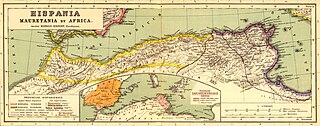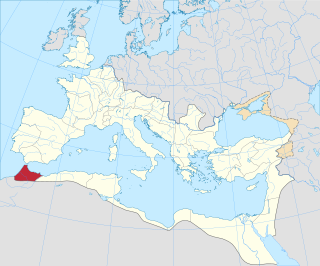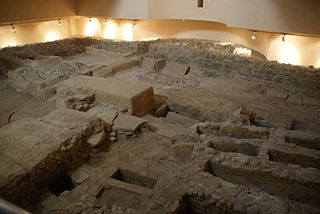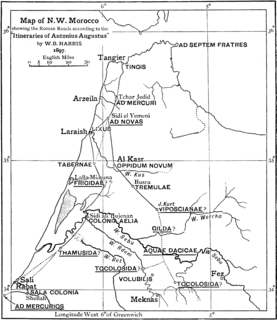
Iulia Campestris Babba is a Mauretanian city created as Roman colony around 30 BC by emperor Augustus. Its actual location is currently unknown, though its existence is confirmed by the literature. [1]

Iulia Campestris Babba is a Mauretanian city created as Roman colony around 30 BC by emperor Augustus. Its actual location is currently unknown, though its existence is confirmed by the literature. [1]
Colonia Iulia Campestris Babba was one of the three colonias in Mauretania Tingitana [2] (in northern Morocco) founded by emperor Augustus between 33 and 25 BC for veterans of the battle of Actium. Nearly 10,000 legionaries settled in Iulia Valentia Banasa, Iulia Constantia Zilil and Babba, according to historian Theodore Mommsen.
The city of Babba in Mauritania Tingitana was probably situated on or near the river Lixus (El Haratel); and was made a colony in honor of Julius Caesar, as its name Iulia indicated. It was also called Campestris because away from the sea [3] The city was populated by Roman colonists and their descendants and by romanised berbers.
The exact location of Babba has been debated by many scholars, [1] but one of the most probable possibilities is that Babba was the "Oppidum Novum" (actual Ksar el-Kebir) of the "Itineraries of Antonius Augustus". Indeed, historian Euzennat believe that "can not be excluded in these circumstances that it was the colonia Iulia, which might have disappeared in the troubles of the second century AD before being reborn as Oppidum novum". [4] But some researchers argue that Babba can be the old Roman city of "Tremulae" (actual Basra) and even the city of Thamusida.

The city was probably abandoned at the end of the third century, by orders of emperor Diocletian. Indeed, Rome's control over the city probably ended following the chaos of the Crisis of the Third Century, when the Roman Empire nearly disintegrated as a series of generals seized and lost power through civil wars, palace coups and assassinations. Roman rule collapsed in much of Mauretania and was never re-established. Only a northern section of Mauretania Tingitana remained under Roman control. In 285 AD, Diocletian reorganised what was left of the province to retain only the coastal strip between Lixus, Tingis and Septem (modern Ceuta).

Mauretania is the Latin name for a region in the ancient Maghreb. It stretched from central present-day Algeria westwards to the Atlantic, covering northern Morocco, and southward to the Atlas Mountains. Its native inhabitants, seminomadic pastoralists of Berber ancestry, were known to the Romans as the Mauri and the Masaesyli.

Mauretania Caesariensis was a Roman province located in what is now Algeria in the Maghreb. The full name refers to its capital Caesarea Mauretaniae.

Mauretania Tingitana was a Roman province located in the Berber world, coinciding roughly with the northern part of present-day Morocco. The territory stretched from the northern peninsula opposite Gibraltar, to Sala Colonia and Volubilis to the south, and as far east as the Mulucha river. Its capital city was Tingis, which is the modern Tangier. Other major cities of the province were Iulia Valentia Banasa, Septem, Rusadir, Lixus and Tamuda.

Tingis or Tingi, the ancient name of Tangier in Morocco, was an important Carthaginian, Moor, and Roman port on the Atlantic Ocean. It was eventually granted the status of a Roman colony and made the capital of the province of Mauretania Tingitana and, after Diocletian's reforms, the diocese of Hispania.

Lixus is the site of an ancient Roman-Berber-Punic city located in Morocco, just north of the modern seaport of Larache on the bank of the Loukkos River. The location was one of the main cities of the Roman province of Mauretania Tingitana.

The Chellah or Shalla, is a medieval fortified Muslim necropolis located in the metro area of Rabat, Morocco, on the south (left) side of the Bou Regreg estuary. The Phoenicians established a trading emporium at the site. This was later the site of an ancient Roman colony in the province of Mauretania Tingitana.

Anfa was the ancient toponym for Casablanca during the classical period. The city was founded by Berbers around the 10th century BC, with the Romans under Augustus later establishing the commercial port of "Anfus" in 15 BC. Anfa is now the name of a district in the oldest part of Casablanca, located in the Casablanca-Settat region of Morocco. The district covers an area of 37.5 square kilometres, and as of 2004 had 492,787 inhabitants.

Tamuda was an ancient Berber city and military camp in Mauretania Tingitana. It is located 6 km west of the present-day Tetouan in northern Morocco. Stone ruins from the site are found by the south bank of the Martil Valley. It was considered a city in accordance with the rules of urbanization of the time.

Zuccabar or Zucchabar was an ancient town in the Roman province of Mauretania Caesariensis. It is located in present-day Miliana, Algeria.

Abyla was the pre-roman name of Ad Septem Fratres. Ad Septem Fratres, usually shortened to Septem or Septa, was a Roman colony in the province of Mauretania Tingitana and a Byzantine outpost in the exarchate of Africa. Its ruins are located within present-day Ceuta, an autonomous Spanish city in northwest Africa.

Rusadir was an ancient Punic and Roman town at what is now Melilla, Spain, in northwest Africa. Under the Roman Empire, it was a colony in the province of Mauretania Tingitana.

Iulia Constantia Zilil was an ancient Roman-Berber city in Dchar Jdid, located 40 km southwest of Tangier and 13 km northeast of Asilah. It was one of the three colonias in Mauretania Tingitana founded by emperor Augustus between 33 and 25 BC for veterans of the battle of Actium.

Iulia Valentia Banasa was a Roman-Berber city in northern Morocco. It was one of the three colonias in Mauretania Tingitana founded by emperor Augustus between 33 and 25 BC for veterans of the battle of Actium, on top of a Mauretanian village. The site was in fact already occupied by the local Amazigh people from the 4th century BC, or perhaps earlier.

Almost all Roman roads in Africa were built in the first two centuries AD. In 14 AD Legio III Augusta completed a road from Tacape to Ammaedara: the first Roman road in Africa. In 42 AD the kingdom of Mauretania was annexed by Rome. Emperor Claudius then restored and widened a Carthaginian trail and extended it west and east. This way the Romans created a continuous coastal highway stretching for 2,100 miles from the Atlantic to the Nile. In 137 Hadrian built the Via Hadriana in the eastern desert of Egypt. It ran from Antinoopolis to Berenice.

Roman roads in Morocco were the western roads of Roman Africa.

Thamusida was a Berber, Carthaginian, and Roman river port that was near the present-day towns of Kénitra and Mehdia in Morocco. Under the Roman Empire, it formed a part of the province of Mauretania Tingitana.

Iulia Traducta was a Roman city in Andalusia, Spain, on the site of the modern Algeciras.

Rapidum was a Roman settlement and fort located in Mauretania Caesariensis, nearly 100 km south of Icosium (Algiers).

Roman colonies in Berber Africa are the cities—populated by Roman citizens—created in Berber North Africa by the Roman Empire, mainly in the period between the reigns of Augustus and Trajan. These colonies were created in the area—now called Tamazgha by the Berbers—located between Morocco and Libyan Tripolitania.

The Limes Mauretaniae was a portion of a 4,000-kilometre (2,500 mi) Roman fortified border (limes) in Africa approximately 100 kilometres (62 mi) south of the modern day Algiers.